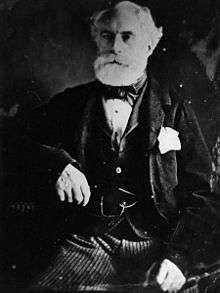William Clements, 3rd Earl of Leitrim
William Sydney Clements, 3rd Earl of Leitrim (15 October 1806 – 2 April 1878), was an Anglo-Irish nobleman and landlord notorious in Irish history for his mistreatment of his tenants. He was assassinated in the north of County Donegal in Ulster in April 1878.

Born in Dublin, he was educated at the Sandhurst and was commissioned as an Ensign in the 43rd Foot in 1824. In 1831 he was promoted Captain, having served in Portugal between 1826 and 1827, and that same year was appointed an aide-de-camp to the Lord Lieutenant of Ireland. In 1835 he transferred to the 51st Foot. In 1839, on the death of his elder brother, he became known as Viscount Clements and also succeeded his brother as a Member of Parliament for County Leitrim, a seat he held until 1847.
On his father's death in 1854, Clements succeeded as 3rd Earl. In 1855 he was promoted Lieutenant-Colonel and subsequently retired from the British Army. Over the next two decades, his overbearing behaviour as a landlord brought him much hatred from his tenants, Catholic and Protestant alike, whom he evicted with equal enthusiasm. According to his biographer Fiona Slevin, Lord Leitrim was accused by some of "repeatedly [violating] young girls and [claiming] droit du seigneur ... some of his peers repeated accusations of his 'immorality towards daughters of tenants' in the House of Commons and named him 'the bad earl'." However, Slevin also quotes a journalist who investigated Lord Leitrim's assassination as claiming, "'even among those who hold the strongest views upon Lord Leitrim's conduct as a landlord, the charge (of debauchery) is discredited and I did not meet a single person who regarded it as tenable.'" In Slevin's words, "the final straw that motivated the individuals involved" in Lord Leitrim's assassination was his alleged rape of the daughter of one of his assassins.[1]
Leitrim was deeply opposed to Gladstone's Irish Land Act of 1870 and was one of eight peers to protest against the legislation when it reached the House of Lords. Among those he also quarrelled with were the Presbyterian minister of Milford in North Donegal, and the Lord Lieutenant himself, The 7th Earl of Carlisle, who removed him from his appointments as a justice of the peace for Counties Leitrim, Donegal, and Galway.
In April 1878, after surviving various attempts on his life, Lord Leitrim was assassinated, along with his clerk and driver, near Cratlagh Wood while on his way to Milford (a village he owned in its entirety) from his home, Manor Vaughan (usually known as Mulroy House), on Mulroy Bay. Michael Heraghty and brothers Thomas and Bernard McGranahan were arrested. "The gun butt had been traced to Heraghty, and paper for the wadding used to load the rifle was traced to a school copybook owned by the McGranahans. The McGranahans were released from Lifford Jail due to a lack of evidence. Heraghty died in Lifford Jail of typhus... The assassins, Nial Shiels of Doughmore, an itinerant tailor, Michael Hergarty of Tullyconnell, and Michael McElwee of Ballyworiskey, were from the remote Fanad Peninsula. In 1877, "McElwee's father was involved in litigation with Leitrim with the result that McElwee was rendered bankrupt, and his house and farm were sold at auction."[2]
Leitrim was buried in Dublin at St Michan's church, amid scenes of great agitation.[3] "The mob wanted to wreak their drunken rage on the dead body of the old Earl, as it was not enough that he had been murdered; and when they were disappointed in their charitable desire to throw the corpse into the street, they howled and yelled an accompaniment of brutal hate to the funeral service. It was a disgraceful affair, scarcely possible in any other latitude of the civilized world."[4]
A monument with a cross was set up at Kindrum in 1960 honoring McElwee, Shiels, and Michael Heraghty as the men whose actions "Ended the tyranny of landlordism".
The murder forms a major element in the plot of the 2005 play The Home Place by Brian Friel.
Biography
- Dolan, Liam The Third Earl of Leitrim (Fanad: James Shields, 1978)
- Malcolmson, A.P.W. (2008). Virtues of a Wicked Earl: The Life and Legend of William Sydney Clements, 3rd Earl of Leitrim. Dublin: Four Courts Press. ISBN 978-1-84682-121-9.
- Slevin, Fiona (2006). By Hereditary Virtues: A History of Lough Rynn. Dublin: Coolabawn Publishing. p. 204. ISBN 0-9553883-0-9. External link in
|publisher=(help)
- Simonsen, Mary Lydon (2017). A Murderer's Country, Joyce Country Galway during Ireland's Land War - 1879-1882. Arizona: Quail Creek Publishing, LLC. ISBN 978-0692910610.
Notes
- Slevin, Fiona (18 January 2014). "William Sydney Clements, 3rd Earl of Leitrim (Lord Leitrim)". Lough Rynn. Retrieved 12 March 2018.
- Simonsen, Mary Lydon, A Murderer's Country, Joyce Country, Galway during Ireland's Land War - 1879-1882
- Slevin, Fiona (2006). By hereditary virtues: a history of Lough Rynn. Ireland: Coolabawn Publishing.
- "Lord Leitrim," New York Tribune, April 12, 1878
<<Dolan, photos on pages 116–117.>>
External links
| Parliament of the United Kingdom | ||
|---|---|---|
| Preceded by Robert Clements, Viscount Clements Samuel White |
Member of Parliament for Leitrim 1839 – 1847 With: Samuel White |
Succeeded by Edward King-Tenison Charles Clements |
| Peerage of Ireland | ||
| Preceded by Nathaniel Clements |
Earl of Leitrim 1854 – 1878 |
Succeeded by Robert Clements |